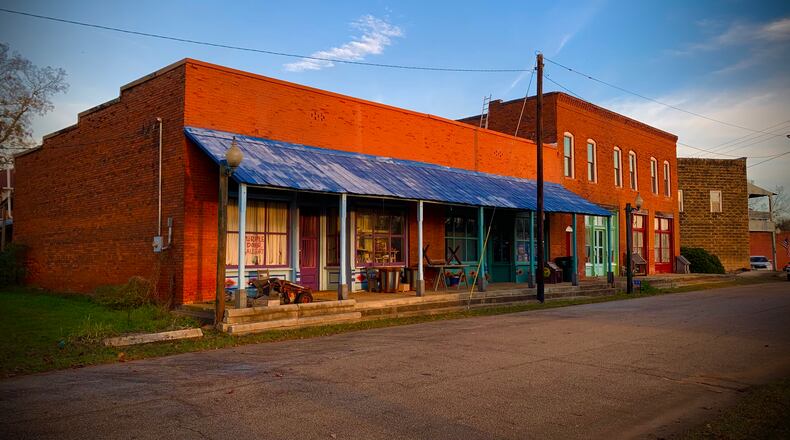Story and photos by Eric Dusenbery
PARROTT, Georgia — The late afternoon sun bathes the brick facades of historic buildings in a soft, warm glow. While cars and trucks roar past on Ga. 520, the sleepy town of Parrott, located between Columbus and Albany in southwest Georgia, retains the patina of an early 20th century community.
Prominent among a cluster of modest buildings on Main Street is a Classical Revival structure with large white columns, double doors and picture windows that shouts former bank. Step inside, and realistic, full-length portraits hang prominently on a rich red wall on the left. On the right, behind the former bank teller’s window, are abstract, modern paintings. Built in 1912, the Pierce Exchange Bank building today contains the gallery and studio space of husband and wife artists France Pierce and June Blackstock.
Credit: Eric Dusenbery
Credit: Eric Dusenbery
The artists seem to personify the tiny town — at once both traditional and modern. Blackstock’s passion is in the human form and face. “I’m trying to render a portrait the way God created it,” she says. “I’m a classical realist.”
Pierce is an abstract painter, working with color, shapes and textures. He shares his name with the bank because his great-grandfather started it.
Located in Terrell County, Parrott has a population of around 150, according to the 2010 census, and it is surrounded by farmland, most of it devoted to growing peanuts. In its past, Parrott was one of the many “Cotton is King” boomtowns. That went bust long ago, but the region’s economy has always centered on agriculture.
Nevertheless, Parrott has a rich cultural history for a small rural town.
Credit: Eric Dusenbery
Credit: Eric Dusenbery
“People have eked out a living from the earth around here,” says Blackstock. “But, somewhat oddly, this is a very cultural and sophisticated place. There’s been a lot of talent that has come out of Parrott,” including Joanna Moore, Tatum O’Neal’s mother, who had a recurring role on “The Andy Griffith Show.”
In 1976, Parrott was the smallest town to welcome Artrain USA, a traveling art exhibit displayed in rolling train cars that toured the country. The event was such a momentous occasion that former Governor and then-presidential candidate Jimmy Carter presided over the opening. Four years later, Parrott was used as a setting for the filming of “The Long Riders,” a Western about Jesse James starring David Carradine, Stacy Keach and Dennis Quaid.
Over the years, Parrott has cycled between times of prosperity and times of hardship. Today, the only business currently occupying space downtown is Maridean’s Marketplace, an antique shop. But Pierce believes it wouldn’t take much to revitalize the town.
“We’re convinced that it needs a restaurant,” Pierce says. “It will drive the whole town. Antique stores and quaint businesses will come in. That’s how it’s been before.”
What’s important to Pierce, Blackstock and other residents of Parrott is that the town survives and hopefully one day thrives.
“There’s not many small little towns like Parrott that are still intact,” says Pierce. “Small towns have a place. Just over 100 years ago, most people in this country lived in places like Parrott. As we become more urbanized, we need to remember our roots.”
Credit: Eric Dusenbery
Credit: Eric Dusenbery
History of a boomtown
First settled as a Creek village called Chenube, Parrott was founded in 1889 by Civil War veteran and prominent landowner John L. Parrott, who donated the land for the commercial district. It was a time of great growth in South Georgia with railroads being built around the state.
“These were dirt streets in the early days,” says former Mayor Eddie Wade as he walks along Railroad Street where turquoise trim, burgundy doors and sea foam green storefronts contrast with the bright orange bricks that give the row of stores a colorful palette. Wade was born and raised here in a farming family.
“During the time I was growing up, all the buildings and stores were occupied,” he says. “On Saturdays, all the farmers and workers would come to town to get groceries and buy things. It was busy. You couldn’t walk up and down on the sidewalks because it was so crowded. Businesses stayed open later on Friday and Saturday nights to accommodate the farmers.”
Credit: Eric Dusenbery
Credit: Eric Dusenbery
Most of the structures in Parrott were built between the 1890s and the 1920s. They included a general mercantile, the bank, a hardware store, a butcher shop, cotton warehouses and cotton gins. In the early years, cotton flourished due to the red clay soil in the area. The railroad ran through town, making Parrott a vital transportation and distribution hub for shipping cotton. In its heyday, the town’s population was over 300.
“Agriculture was the main reason people came to the area,” Wade says. “Some came in as merchants, some as bankers, and there were doctors, a dentist, school teachers — but it all was associated primarily with agriculture.
“A lot of times, during harvest season, when they started cotton ginning, if they couldn’t store the cotton bales in the warehouses they’d line the streets with it,” he says. “We played on the cotton bales downtown. You could walk all over town on those cotton bales. There was cotton everywhere.”
Once the cotton market declined, farmers in the area transitioned to peanuts — not just growing them but processing them, too, thanks to the development of shelling machines that hulled the peanuts using grates, blowers and gravity to separate the kernels. Parrott ultimately gained prominence as a center for processing and shipping the crop.
Credit: Eric Dusenbery
Credit: Eric Dusenbery
Hope for the future
As an adult, Wade left Parrott for Atlanta where he had a career at Delta Air Lines as manager of administration and purchasing automation. But when he retired in 1992, he moved back with an eye on downtown Parrott, which had fallen into decline.
“My wife’s grandfather’s drugstore was for sale,” he says. “She always had a lot of fond memories of that store, so I bought it. In working out the deal, the owner talked me into buying a couple of the other buildings. So, I ended up buying four buildings. We started renovating — they were in really bad shape. We started building the town back up a little bit.”
By 1998, the town experienced an economic boom.
“We had it going real good for a while,” he says. “We had little bit of everything.” There were 13 businesses in all, including five antiques stores, a tea room and a popular restaurant patronized by the former President and First Lady Jimmy and Rosalynn Carter.
What happened? It depends on who you ask. Wade believes things went bust because of 9/11.
“People suddenly looked at life a little differently,” he says. “Some people just wanted to stay home and be with families. Business dropped off. People who had businesses didn’t weather the storm. People weren’t buying. Most of the businesses that decided to close did not reopen after that. I just don’t think it’s going to get back to where it was.”
But, Rachel Weitnauer, a descendent of town founder John Parrott, believes there is another reason businesses closed.
Credit: Eric Dusenbery
Credit: Eric Dusenbery
“Someone forgot to tell the business owners that it wasn’t just something fun for them to do because they’d always wanted to own an antique shop,” she says. “You had to be committed to staying open for whatever hours you had on your sign. When 1 or 2 o’clock in the afternoon came around and they didn’t have any customers for 30 minutes and got bored, they just closed up shop and went home. So, people didn’t come back. They thought, ‘I’m not going to drive all the way to Parrott and not have anyone be there.’”
Technological advances in the agricultural industry also played a role, Weitnauer says.
“When mechanization really came in, the farmers no longer hired as many people to work for them so that made a difference in the number of people that were around,” she says. “There wasn’t much for farmhands or workers to do, so they went to cities or somewhere else. There are people who say, ‘If I could find a way to make a living here and keep it sustainable, I would do it.’ They love the town — like I do.”
Weitnauer tells the story of J.T. Thornton, who designed a peanut shaker that revolutionized the peanut industry in the 1940s by automating the harvesting process. He brought it downtown and proudly showed the townfolk of Parrott his invention. Unfortunately, he didn’t know about patents, and others copied his design. He is still remembered for inventing the machine, though.
Thornton serves as a metaphor for Parrott. The town’s glory days are just a memory, and while it doesn’t have much to show for it in the way of riches, its legacy is highly prized. But for those who remember what once made Parrott great, hope remains that it can be great again.
About the Author










